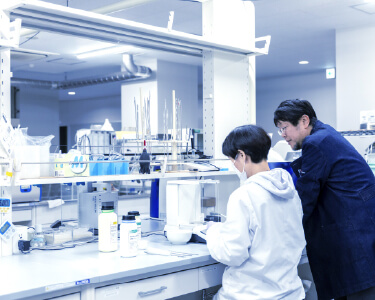
Research
Leading the world in photocatalyst research to practical use of green hydrogen
We study particulate photocatalysts and reaction systems for sunlight-driven water splitting toward practical application of green hydrogen derived from water. We have focused on oxynitride, nitride, and oxysulfide semiconductor material since the very beginning and have been developing them as photocatalysts for water splitting. Some of these materials absorb sunlight sufficiently and have band structures suitable for photocatalytic water splitting. We investigate the correlation among preparation methods, physical properties, and functionality of photocatalysts to improve their performance. We are also involved in the development of reaction systems suitable for large-scale applications by taking advantage of the properties of particulate materials. Through these studies, we will contribute to solving energy and environmental problems.
About research
Overview
Modern societies rely on the mass consumption of energy resources, and most of the primary energy is derived from fossil resources. It is concerned that energy and environmental problems will become more serious on a global scale if our societies continue to develop while heavily relying on fossil resources. Hydrogen has been attracting attention as an energy alternative to fossil fuels. However, currently, fossil resources are used in various processes of hydrogen production. To solve energy and environmental problems from the root, it is necessary to develop technologies that can efficiently mass-produce green hydrogen, which does not involve carbon dioxide emissions during the production process.
Sunlight-drive water splitting has been studied as a technology to produce green hydrogen. In our laboratory, we study particulate photocatalysts and reaction systems for sunlight-driven water splitting toward practical application of this technology. The photocatalysts considered here are semiconductors and absorb photons to generate negatively charged electrons and positively charged holes at excited states, which trigger redox reactions associated with water splitting. Systems based on particulate photocatalysts consists of relatively simple components and can be scaled up potentially by using inexpensive processes. Therefore, the development of photocatalysts highly active for the sunlight-drive water splitting reaction will be a major step towards practical large-scale green hydrogen production.
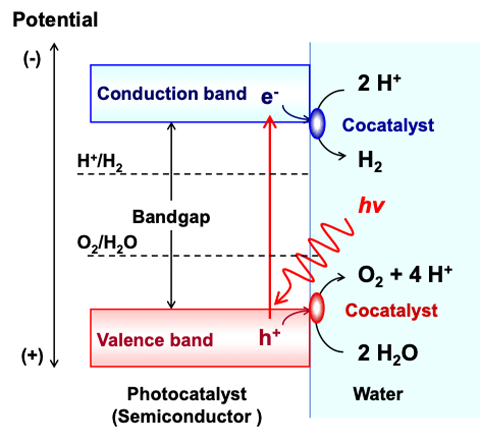
To harvest solar energy effectively, it is necessary to develop photocatalysts that are active under visible light. In our laboratory, we mainly study particulate oxynitride, nitride, and oxysulfide semiconductors as photocatalyst materials. Many of these materials are known to strongly absorb long-wavelength visible light. To make these photocatalyst materials highly active, we investigate in detail correlations among synthesis and modification methods, physical properties, and photocatalysis of the materials. We also develop reaction systems suitable for large-scale applications taking advantage of the properties of particulate materials.
References
https://www.nature.com/articles/s41929-019-0242-6
https://www.nature.com/articles/s41578-025-00823-0

Oxide photocatalysts
SrTiO3 is one of the particulate photocatalysts that was reported by Special Emeritus Professor Kazunari Domen in 1980 to exhibit activity in the overall water splitting reaction for the first time in the world, and it is still well studied as a model water-splitting photocatalyst. Our laboratory found that the water-splitting activity of SrTiO3 was significantly improved by doping lower- valent metal cations. In particular, Al-doped SrTiO3 drove the overall water splitting reaction with external quantum efficiencies exceeding 90% in the near-ultraviolet region when site- selectively coloaded with hydrogen and oxygen evolution cocatalysts. This result demonstrates that even a particulate photocatalyst with a relatively simple structure can drive the endergonic water splitting reaction with a high quantum efficiency comparable to that of the light/chemical energy conversion process in natural photosynthesis and has a very important meaning in designing and developing particulate photocatalysts. The developed photocatalyst was used in a 100 m2 scale water-splitting photocatalyst panel reaction system described later, pushing the research and development forward.
Reference
https://pubs.rsc.org/en/content/articlelanding/1980/c3/c39800000543
https://www.nature.com/articles/s41586-020-2278-9
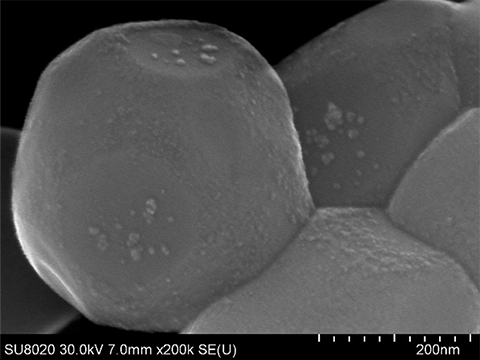
Oxynitride and nitride photocatalysts
It has been known since around 2000 that oxynitrides and nitrides shows activity in hydrogen and oxygen evolution reactions from aqueous solutions under visible light irradiation. Ta3N5 is one of such nitride materials and absorbs visible light with wavelengths of up to 600 nm. However, due to the difficulty in synthesizing high-quality Ta3N5 particles, overall water splitting had not been accomplished using Ta3N5 photocatalysts. In our laboratory, we surveyed the starting materials and synthesis conditions for Ta3N5 and produced Ta3N5 single-crystal nanorods that were active in the overall water splitting reaction. This Ta3N5 was obtained by nitriding KTaO3 for a short time. Ta3N5 single crystals with a low defect density were directly formed on the KTaO3 particles during the nitridation with gradual evaporation of the K component. Loading of an appropriate hydrogen evolution cocatalyst enabled the single-crystal Ta3N5 nanorods to utilize photoexcited charge carriers for the water splitting reaction.
Reference(s)
https://www.nature.com/articles/s41929-018-0134-1
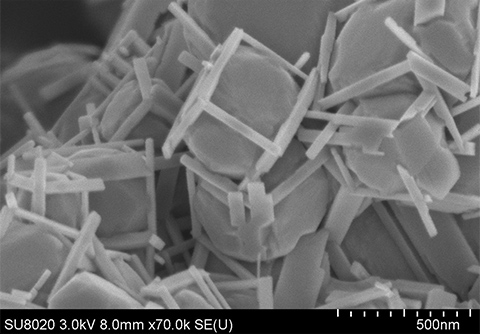
BaTaO2N is an oxynitride material that absorbs visible light up to 650 nm. However, it was difficult to deposit cocatalysts with high dispersion and intimate contact, and photoexcited charge carriers were not utilized efficiently for the hydrogen evolution reaction. In our laboratory, we found that highly-dispersed Pt cocatalyst particles could be loaded on single-crystalline BaTaO2N particles synthesized by a flux method by applying an impregnation-hydrogen reduction method and a photodeposition method sequentially. The resultant Pt-loaded BaTaO2N photocatalyst exhibited significantly improved hydrogen evolution activity and also improved the efficiency of the two-step excitation (Z-scheme) water splitting reaction in combination with an oxygen evolution photocatalyst. It was found by transient absorption spectroscopy that recombination of electrons and holes was suppressed because the Pt cocatalyst particles loaded by this method efficiently extracted electrons from the BaTaO2N photocatalyst. It was also found that the use of BaTaO2N with a low defect density was important for loading highly dispersed Pt cocatalysts.
Reference(s)
https://www.nature.com/articles/s41467-021-21284-3
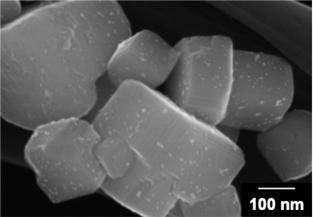
SrTaO2N is an oxynitride material that absorbs visible light up to 600 nm. Using conventional preparation methods, it has been difficult to synthesize small, well-crystalline particles suitable for transporting photoexcited carriers to the surface. Our laboratory discovered that SrTaO2N particles smaller than 100 nm can be synthesized using the sulfide TaS2 as a raw material. Furthermore, by using the synthesized SrTaO2N in combination with an oxygen evolution photocatalyst, the efficiency of two-step excitation (Z-scheme) water splitting was improved. Other perovskite-type Ta-based oxynitride photocatalysts with small particle sizes can also be synthesized using TaS2 as a raw material. The high reactivity of TaS2 in chloride molten salts is thought to play an important role in reducing the particle size of the oxynitrides.
Reference(s)
https://www.nature.com/articles/s41467-023-43838-3
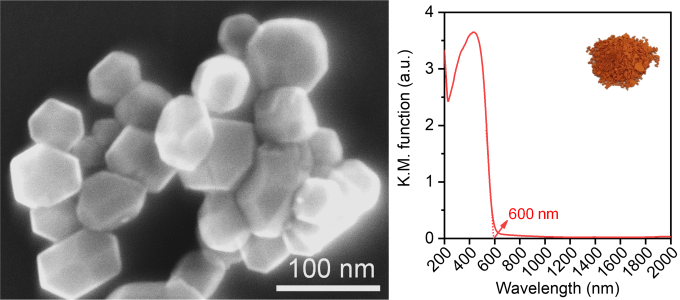
Solid solutions of GaN and ZnO (GaN:ZnO) exhibit an interesting property: they absorb visible light even though GaN and ZnO only absorb ultraviolet light. Additionally, their absorption edge wavelength becomes longer with higher concentrations of ZnO. GaN:ZnO is typically synthesized through thermal nitridation under an ammonia flow. However, due to the reduction and volatilization of ZnO during nitridation, it was not possible to synthesize GaN:ZnO with high crystallinity required for high activity and a high ZnO concentration required for long-wavelength visible light absorption. Our laboratory discovered that reacting GaN:ZnO raw materials with solid nitrogen sources in a sealed evacuated tube can produce hexagonal, columnar, single-crystalline GaN:ZnO particles with a high ZnO concentration that reflect the crystal structure. Owing to the high ZnO concentration, the obtained GaN:ZnO exhibited an absorption edge wavelength of approximately 600 nm, nearly 100 nm longer than conventional GaN:ZnO. This material drove the visible-light oxygen evolution reaction with an external quantum efficiency of around 12%, in addition to demonstrating visible-light water splitting activity.
Reference(s)
https://pubs.rsc.org/en/content/articlelanding/2024/ta/d4ta03576c
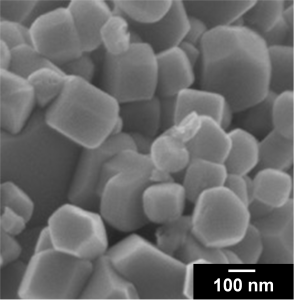
Oxysulfide photocatalysts
Oxysulfides are more stable than sulfides in water under light irradiation, and some materials have been known to have a band structure suitable for water splitting into hydrogen and oxygen in a weakly alkaline aqueous solution since around 2000. However, overall water splitting using oxysulfide photocatalysts had not been achieved for many years due to the lack of synthesis and cocatalyst loading suitable for photocatalytic applications. Through survey of stable oxysulfide photocatalyst materials, our laboratory succeeded in the over water splitting reaction using Y2Ti2O5S2, a layered perovskite-type oxysulfide absorbing visible light with wavelengths of up to 640 nm. To achieve the reaction, it was necessary to coload Y2Ti2O5S2 with Cr2O3-coated Rh as a hydrogen evolution cocatalyst and IrO2 as an oxygen evolution cocatalyst and to precisely control the pH value of the reaction solution. Further improvements in the performance are expected through refinements in the preparation methods of oxysulfide materials and cocatalysts.
Reference(s)
https://www.nature.com/articles/s41563-019-0399-z
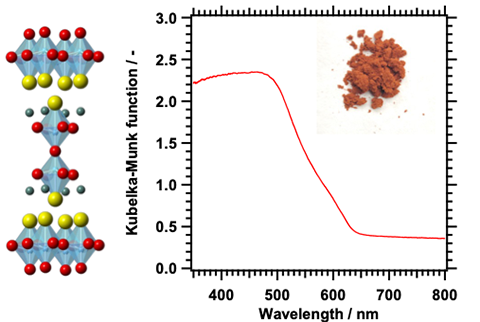
Gd2Ti2O5S2 is a layered perovskite oxysulfide that exhibits a photocatalytic activity in response to visible light up to 640 nm, similar to Y2Ti2O5S2. Our laboratory has significantly increased the hydrogen evolution activity of Gd2Ti2O5S2 through investigating synthetic and surface modification methods. Plate-like, single-crystal particles with well-ordered atomic arrangements extending to the surface were obtained by synthesizing Gd2Ti2O5S2 using the flux method and subsequent acid etching. Microwave-assisted heating and photodeposition were then used to load cocatalysts, enabling Gd2Ti2O5S2 to drive the hydrogen evolution reaction with an external quantum efficiency of 30% at a wavelength of 420 nm. These photocatalyst preparation methods can be applied to Sm2Ti2O5S2 and have been used to develop various highly active oxysulfide photocatalysts and photocatalyst sheets.
Reference(s)
https://onlinelibrary.wiley.com/doi/full/10.1002/anie.202312938
Photocatalyst sheets
It is possible to split water into hydrogen and oxygen using two-step photoexcitation by combining hydrogen evolution photocatalysts (HEPs) and oxygen evolution photocatalysts (OEPs). Such photocatalytic systems are called Z-scheme systems after the photoexcitation process of natural photosynthesis. In our laboratory, we applied the particle transfer method, a method to fabricate particulate electrodes with low contact resistance, to prepare Z-schematic water-splitting particulate photocatalyst sheets in which HEPs and OEPs were blended and fixed on a thin film of conductive material. A photocatalyst sheet based on La,Rh co-doped SrTiO3 as a HEP and Mo-doped BiVO4 as an OEP immobilized on an Au thin film exhibited high water-splitting activity even in pure water. Notably, the photocatalyst sheet could maintain the water-splitting activity even when they were expanded to a large area, because evolution of hydrogen and oxygen occurred in close proximity, and the influence of solution resistance and mass transfer resistance could be minimized. In addition, we found that the excellent water-splitting performance was maintained even under atmospheric pressure, which was assumed to be practical conditions, when materials effective in preventing reverse reactions were applied. The solar-to-hydrogen energy conversion efficiency at the atmospheric pressure reached 1.0%, the highest ever reported using particulate photocatalysts. We will continue to develop photocatalyst sheets for water splitting using non-oxide photocatalyst materials, aiming for effective use of visible light with longer wavelengths.
Reference(s)
https://www.nature.com/articles/nmat4589
https://pubs.acs.org/doi/10.1021/jacs.6b12164
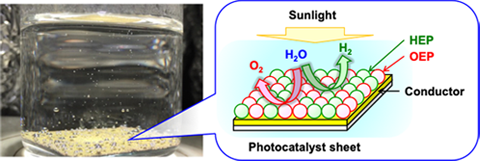
The aforementioned Z-scheme photocatalyst sheet requires vacuum and calcination processes, making it difficult to apply non-oxide photocatalyst materials with low heat resistance or to scale up the system. Our laboratory found that a Z-scheme photocatalyst sheet that drives the water splitting reaction can easily be produced by filtering a suspension of HEP, OEP, and carbon-based conductive materials. Despite the simplicity of the required equipment and processes, the photocatalyst sheet produced by filtration split water and produce hydrogen with an energy conversion efficiency of 0.4%. These achievements have already been showcased at the 2025 Osaka-Kansai Expo and will pave the way for large-scale applications of long-wavelength photoresponsive photocatalysts.
Reference(s)
https://www.sciencedirect.com/science/article/abs/pii/S2667109324004421
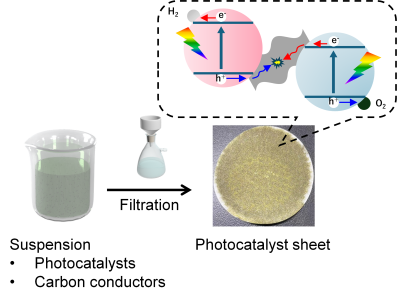
Photocatalyst panel reaction systems
Our laboratory develops panel reaction systems toward large-scale application of particulate photocatalysts for water splitting. The aforementioned Al-doped SrTiO3 photocatalyst can be readily processed into sheet by coating onto substrates. It has been confirmed that such photocatalyst sheets housed in a panel reactor can decompose water continuously and transport the generated gas smoothly even when the water thickness is merely 0.1 mm. In 2019, in collaboration with the Domen Laboratory of the University of Tokyo, the construction of large-area water-splitting panel reaction systems was started, and the operating characteristics of the photocatalyst panels and associated equipment are under investigation for a long time. The reaction system, which consisted of a photocatalytic panel reactor with a light-receiving area of 100 m2 and a gas separation module based on separation membranes, continuously decomposed water for about one year in an outdoor environment. In addition, by connecting the gas separation module, hydrogen gas was separated from the generated hydrogen-oxygen mixed gas with a purity of 96.5% at a recovery rate of 95%. Furthermore, by installing a mechanism controlling the gas flow rate in the gas separation module autonomously, the gas separation performance was maintained regardless of the sunshine conditions. Further research is in progress to reduce the cost and increase the scale of photocatalyst panel reactors and improve the separation performance and energy efficiency of the gas separation processes. Additionally, one of the largest demonstrations of photocatalytic hydrogen production in Japan is planned on a 5,000-m2 plot of land in Iida City, Nagano Prefecture.
References
https://www.nature.com/articles/s41586-021-03907-3
https://pubs.acs.org/doi/full/10.1021/acsengineeringau.3c00034
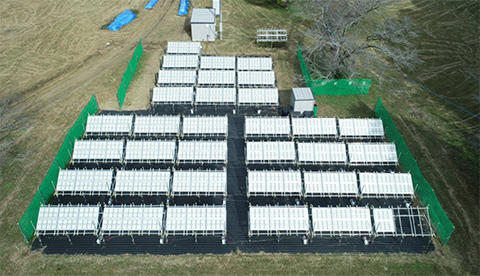
Affiliated researchers

-
Principal Investigator (PI)
HISATOMI, TakashiDistinguished Professor
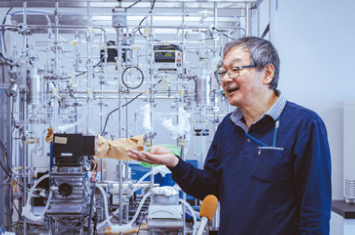
-
DOMEN, KazunariSpecial Emeritus Professor

-
NISHIYAMA, HiroshiProfessor


